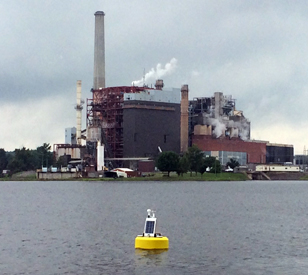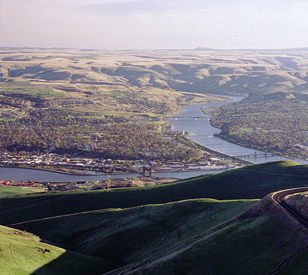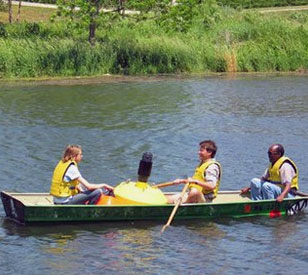Temperature Profiling

Surface waters including lakes and oceans commonly undergo seasonal temperature changes from factors like currents, wind and sun heating the water surface. Temperature affects water density and can result in stratification, with warmer upper layers separated from colder, denser lower layers. Temperature profiling involves deployment of thermistor strings with multiple sensors in the water column to measure and track such gradients.
Water Column Temperature

Typical Temperature Profiling System
Temperature profiling strings are most commonly deployed from data buoy platforms, which are easy to deploy and relocate as needed and offer flexible mooring options for deployment in almost any location.
The NexSens CB-450 buoy is an ideal platform for temperature profiling. It is light enough to be deployed from most small boats, yet large and powerful enough with its on-board battery and three solar panels for continuous operation and potential expansion with weather and water quality sensors. It supports an M550 solar marine light for nighttime visibility.
NexSens manufactures two types of temperature profiling strings. T-Node FR systems have interchangeable sensors and cables with waterproof UW connectors which allow the user to build and modify strings. TS210 temperature strings provide similarly high accuracy, but with thermistors built into a fully-sealed, marine-grade cable at user-specified depths. Both can be securely fixed to mooring lines with TS-Clamp mooring clamp kits.
The X3 environmental data logger simplifies sensor connections and transmission of real-time data via 4G LTE cellular or Iridium satellite telemetry to the WQData LIVE web datacenter, where data can be viewed and alarms configured to provide notice when critical thresholds are exceeded. Multiple waterproof sensor ports and automatic sensor detection simplify startup and expansion with various sensor types.
Contact a NexSens Applications Engineer today to discuss your temperature profiling application.

Case Studies
Managing Plant Discharge Temperatures
The Southern Illinois Power Cooperative operates a power plant near Lake of Egypt around the clock to produce energy for its customers. All the activity can stress the plant’s infrastructure, so key to continuing its operations is minimizing that stress as much as possible. One of the main issues that plant managers encounter in overseeing operations is keeping equipment from overheating. They routinely pump in water from the lake to cool generators and ensure reliable power generation in the long term. Through being used as a cooling agent, the water is heated up considerably, and then must be condensed and cooled before it can be discharged back into the reservoir.
Read MoreWashington Reservoir Temperature Changes
There are many major rivers flowing through the Pacific Northwest. Like others around the country, they are outfitted with various dams and reservoirs that are used to control their movements, provide energy and maintain drinking water supplies for those living around them. The U.S. Army Corps of Engineers (USACE) plays a big hand in managing and maintaining the structures that corral these rivers. Of significance for engineers with the USACE’s Walla Walla District are the Columbia, Snake and North Fork Clearwater Rivers.
Read MoreLake Temperature Profile
The Carleton College Department of Geology is enhancing classroom learning and student/faculty research with real-time water quality data. A National Science Foundation Grant funded the purchase and deployment of a water quality buoy on Upper Lyman Lake. The new buoy logs temperature data at four depths every 15 minutes. Once per hour, the data is transmitted by radio telemetry to the college’s geology lab. Temperature profile data is posted to a website for student and professor access.
Read More




